Properties of Seam:
The line along which a number of layers of fabrics are joined is called the seam. There are various properties of seam those are essential to make a perfect garment. Seam is created in sewing of fabrics or by joining of fabrics in any other alternative way. The main target of sewing is to make a seam of good appearance and of qualitative performance so that it becomes as per standard quality and in cheaper price. Seam is an important thing in garments making.
The good appearance seams means the stitches in the seam are in correct and in uniform sizes and they do not do any harm of the fabric. In addition to that, the fabric along the sewing line will remain smooth and there will be no gathering. Although gathering is not allowed in seams, sometimes gatherings are created in seams intentionally for the sake of creating designs. Various techniques are adopted for making good appearance of seams in fabrics of various types of fibers and their various constructions. It is to be ensured that the appearance of the seams will remain intact during the use of the garments or during their wash after the making of the garments.

Seam will be more perfect if it maintains some properties when is used in garments. The qualities of seams are meant for their strength, elasticity, durability, security and the special characteristics of the fabric, if there are any, for example, water proofing or flame proofing etc. The required characteristics of the seams are discussed below:
Seam strength:
Seam strength should be equal to or a little bit lower than the strength of the fabric. The strength of this seam should be applicable both in length and in width. If the strength of the seam is greater than the strength of the fabrics, sue to application of unexpected excessive force, fabric may tear, which we do not expect.
Elasticity:
The fabric of the garment may be stretched due to the application of force, then the seam will also have to be stretched along with the fabric of the garment and after the withdrawal of force, seam will also have to return back to its prior position along with the fabric. This means, the elasticity of the seam has to be equal to or greater than the elasticity of the fabric. Otherwise, the sewing thread in the seam may be cut off. It is needed to be remembered that some fabrics or garments may stretch 100% or more than that.
Durability:
The seam should be durable at least up to the time of duration of the garment or the fabric of the garment. Specially, during the time of using and the time of washing, care should be taken so that seam is not damaged or destroyed due to rubbing.
Security:
During the wearing of the garment there should have guarantee so that for normal reasons the seam will not be opened due to the opening or breaking of the thread, otherwise an embarrassing situation may happen.
Comfort:
Some garments such as, underwear, undergarment or bra etc. which are closely adhered to the body, the seam of those garments should be like that so that discomfort or any other problems do not arise.
Special properties of a seam:
Some garments or fabrics are fully water proof. During sewing of those garments, if they are sewn with needle and thread, then water may enter into through the holes created by sewing process and thus the characteristic of water-repellent of the garment may be damaged. In such a situation, the seam line has to be covered by tape or the holes created by sewing should be closed by some other way, so that water cannot enter into through those holes. But if the seam is made in alternative way such as welding process, then a good amount of water-repellent characteristic is obtained.
There are some garments which have the quality of fire proof. The sewing thread to be used for sewing of those garments must also have the quality of fire proof, otherwise the fire proof quality of the garment will be damaged.
Seams may be of different types and these types of seams are sewn by different types of machines. If the same kind of seams are sewn by different types of machines, then differences arise there in the appearance of the seams, in their quality and in the production expenditure. The production plan is adopted based on the price of the garments, their qualities and on the types of the sewing machines. In order to ensure the satisfactory appearance of the seams, five factors are considered and selected with caution which are: seam type, stitch type, feed mechanism of the sewing machines, needle size and the type and size of thread.
